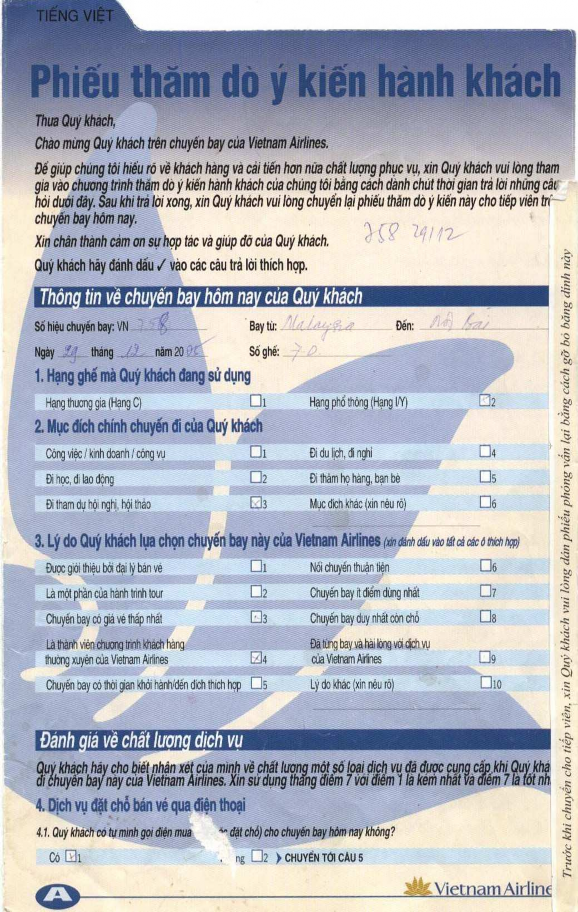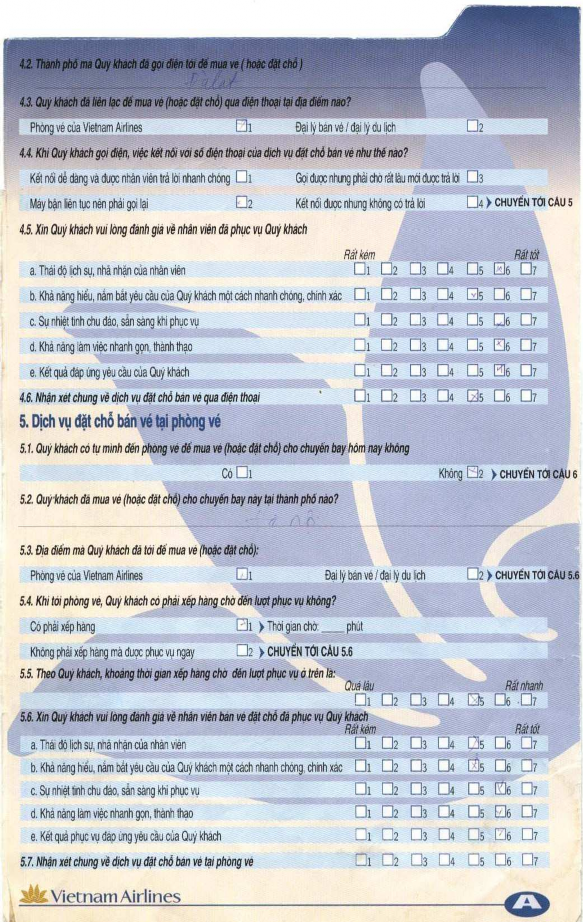4. Một qui trình tương tự như tác giả đã làm khi nghiên cứu chất lượng dịch vụ hàng không có thể được áp dụng trong các ngành dịch vụ khác như ngân hàng, tài chính, khách sạn, giáo dục. Trước khi thu thập thông tin thông qua phiếu hỏi, cần phải dựng được mô hình gồm các bước trong qui trình cung ứng dịch vụ cụ thể, và các yếu tố thuộc chất lượng kĩ thuật và chất lượng chức năng. Các tiêu chí đo chất lượng chức năng rất quan trọng, đặc biệt đối với những ngành như giáo dục, tài chính, do vậy cần đưa đủ các biến quan sát được trực tiếp dưới dạng các câu hỏi vào trong phiếu thăm dò khách hàng.
5. Hai phương pháp phân tích nhân tố và SEM có thể sử dụng được để nghiên cứu các vấn đề trìu tượng và mang tính tâm lý như chất lượng dịch vụ, sự thỏa mãn, định hướng khách hàng vvv tại Việt nam. Một phương pháp thường hay được sử dụng trước đây là hồi qui đa biến vẫn có thể sử dụng được khi nghiên cứu các hiện tượng này, tuy nhiên sử dụng phương pháp này thường mất dữ liệu nhiều do ảnh hưởng của đa cộng tuyến, do các yếu tố tâm lý thường có quan hệ tương quan chặt chẽ với nhau, do vậy không thể đưa vào thành các biến độc lập trong mô hình hồi qui đa biến. Phương pháp phân tích nhân tố và SEM cho phép giải quyết vấn đề đa cộng tuyến trong mô hình.
DANH MỤC CÔNG TRÌNH CỦA TÁC GIẢ
1. Trần Phương Lan (2003), “Tăng cường năng lực cạnh tranh thông qua liên kết ngành”, Tạp chí Kinh tế phát triển, Số 78, tháng 12/2003, Hà Nội.
2. Trần Phương Lan (2004), “Chất lượng dịch vụ và một số phương pháp quản lý chất lượng dịch vụ đang được áp dụng trên thế giới”, Tạp chí Kinh tế phát triển, Số 84, tháng 6/2004, Hà Nội.
3. Trần Phương Lan (2007), “Một số vấn đề cơ bản trong quan niệm hiện đại về quản trị chất lượng dịch vụ”, Tạp chí Kinh tế phát triển, Số 122, tháng 8/2007, Hà Nội.
4. Trần Phương Lan (2007), “Biến tiềm ẩn và ứng dụng trong nghiên cứu các nhân tố ảnh hưởng đến sự hài lòng của khách hàng”, Tạp chí Thương mại, Số 19, tháng 8/2007, Hà Nội.
Có thể bạn quan tâm!
-
 Chất lượng dịch vụ hàng không của Hãng hàng không quốc gia Việt Nam - 19
Chất lượng dịch vụ hàng không của Hãng hàng không quốc gia Việt Nam - 19 -
 Chất lượng dịch vụ hàng không của Hãng hàng không quốc gia Việt Nam - 20
Chất lượng dịch vụ hàng không của Hãng hàng không quốc gia Việt Nam - 20 -
 Chất lượng dịch vụ hàng không của Hãng hàng không quốc gia Việt Nam - 21
Chất lượng dịch vụ hàng không của Hãng hàng không quốc gia Việt Nam - 21 -
 Chất lượng dịch vụ hàng không của Hãng hàng không quốc gia Việt Nam - 23
Chất lượng dịch vụ hàng không của Hãng hàng không quốc gia Việt Nam - 23 -
 Chất lượng dịch vụ hàng không của Hãng hàng không quốc gia Việt Nam - 24
Chất lượng dịch vụ hàng không của Hãng hàng không quốc gia Việt Nam - 24 -
 Chất lượng dịch vụ hàng không của Hãng hàng không quốc gia Việt Nam - 25
Chất lượng dịch vụ hàng không của Hãng hàng không quốc gia Việt Nam - 25
Xem toàn bộ 204 trang tài liệu này.
TÀI LIỆU THAM KHẢO
1. Asubonteng et al., (2001), “Servqual Revisited: A critical Review of Service Quality”, Journal of Service Marketing, Vol 10, No. 6.
2. Bitner, Mary, Bernard and Tetreault (1990), “The service Encounter: Dianosing the favorable and unfavorable Incidents”, Journal of Marketing, Pg 71-84.
3. Bollen, K.A (1989, 2003). Correlation and causality. New York:Wiley
4. Bolton and Drew (1991), “A Multistages Model of customers’ Assessment of service quality and Value”, Journal of Consumer Research. Vol 17, No. 4, 375-384
5. Byrne, (2001). Non recursive causal models. Beverly Hills, CA:Sage
6. Byrne, M.B.(2001). Structural Equation Modeling with AMOS. Lawrence Erlbaum Assocociate Publishers. London
7. Carmen, James M. and Eric Langeard (1980), "Growth Strategies of Service Firms," Strategic. Management Journal, 1 (January-March), pp. 7-22
8. Chandon, Leo et Philippine (1997), “Service Encounter Dimension-a dyadic perspective: measuring the dimensions of service encounters as perceived by customers and personnel”, International Journal of Service Industry Marketing, Vol 18
9. Churchill, G.A. Jr. and C. Suprenaut (1982), "An Investigation into the Determinants of Customer. Satisfaction," Journal of Marketing Research, 19 (November), pp. 491-504
10.Colgate (2001), “Switching barrier in consumer markets: an investigation of the financial service industry”, Journal of consumer marketing, Jul 2001, Vol 18
11.Cronin and Taylor, (1992), “Measuring Service quality: A re-examination & extension”, Journal of Marketing. Vol 56, No 3, 55-68
12.D.Randall Brandt (1996), “Customer satisfaction indexing”, Conference Paper, American Marketing Association
13.Edwards, J.R & Bagozzi, R.P. (2000). “On the nature & direction of relationships between construct and measures”. Psychological Methods
14.Fornell, C. and Larcker, D.F.(1981). Evaluating Structural Equation Modelling in Marketing and Consumer research: A review. International Journal of research in marketing
15.Ganesh, Arnolds & Reynolds (2000), “Understanding the customer base of service providers:An examination of differences between switchers and stayers”, Journal of marketing. Vol 64, 65-67
16.Gower Publishing (1994), Gower handbook of quality management. Dennis Lock, editor. Brookfield, VT
17.Hair, Jr.J.F., Anderson, R.E. , Tatham, R.L. and Black, W.C.(1998).
Mutivariate data analysis, 5th ed. Upper Saddle River:NJ. Prentice Hall
18.Joreskog KG (1969), Ageneral approach to confirmary maximum likehood factor analysis. Psychometicka 34
19.Kenny, D.C (1979). Correlation and Causality. New York: Wiley
20.Lewis, B.R. (1989), "Quality in the service sector: a review", International Journal of Bank Marketing, Vol. 7 No.5
21.Lewis, Robert C. and Bernard H. Booms (1983), "The Marketing Aspects of Service Quality", in Emerging Perspectives on Services Marketing, L. Berry,
G. Shostack and G. Upah, eds., Chicago:American Marketing, pp. 99-107
22..Mac Callum RC, AustinJT (2000). Applications of structural equation modeling in psychological research. Anunu.Rev. Psycho. 51
23.Melville (1995), “The transition to customer service: the IT department challenge”, Managing Service Quality. Vol 18
24.Mohr, Kathrin. "Service Works from the Inside Out" Making, Serving, Keeping Customers, October 12, 1992
25.Nunnally JC. (1978). Psychometric Theory. New York:McGraw Hill
26.Parasuraman, A., et al. "A Conceptual Model of Service Quality and its Implications for Future Research." Journal of Marketing, Fall 1985
27.Philips Kotler (2001), “Marketing Management”. Pearson Custom Publishing
28.Rossi, Peter, et al. (eds.), (1983) Handbook of Survey Research. San Diego, CA: Academic Press Inc.
29.Rubenstein D.I. & R. W. Wrangham (1986). Sociecology: Origins and trends. In: Ecological aspect of social evolution . Princeton University Press, Princeton, NJ
30.Stostack, G.Lynn (1984), “Designing services that deliver”, Harvard Business Review. Jan-Feb. Pg 133-139
31.Takeuchi, Hirotaka and John A Quelch (1983), "Quality Is More Than Making a Good Product”, Harvard Business Review, 61 (July-augus)t
32.University of Houston (1995), Report of round table disscusion on Service quality management at College of Business
33.Upah, Gregory D. (1980), "Mass Marketing in Service Retailing: A Review and Synthesis of Major, Methods," Journal of Retailing, 56 (Fall), pp. 56-76
34.Wisniewski (2005), “Measring service quality in a hospital colposcopy clinic”, International Journal of Health Care Quality Assurance. ISSN: 0952-6862. Vo 18, ISS 3, 217-228
35.Zeithaml, Valerie A., et al., (1990) Delivering Quality Service: Balancing Customer Perceptions and Expectations. New York: Free Press
36.Zeithhaml, Valerie A. (1981) "How Consumer Evaluation Processes Differ Between Goods and Services in Marketing of Services”, J. Donnelly and W. George, eds., Chicago: American Marketing
PHỤ LỤC I








